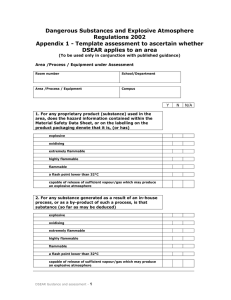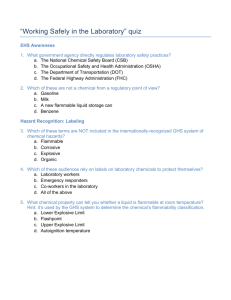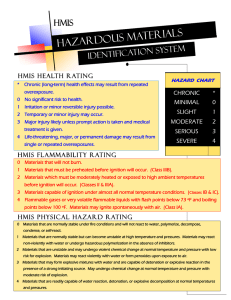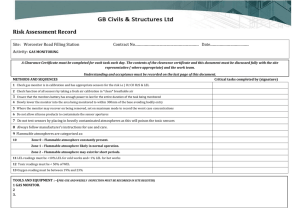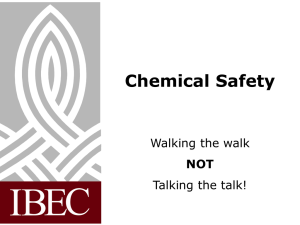Controlling the Explosion Hazard in Vessels, Tanks and Piping
advertisement
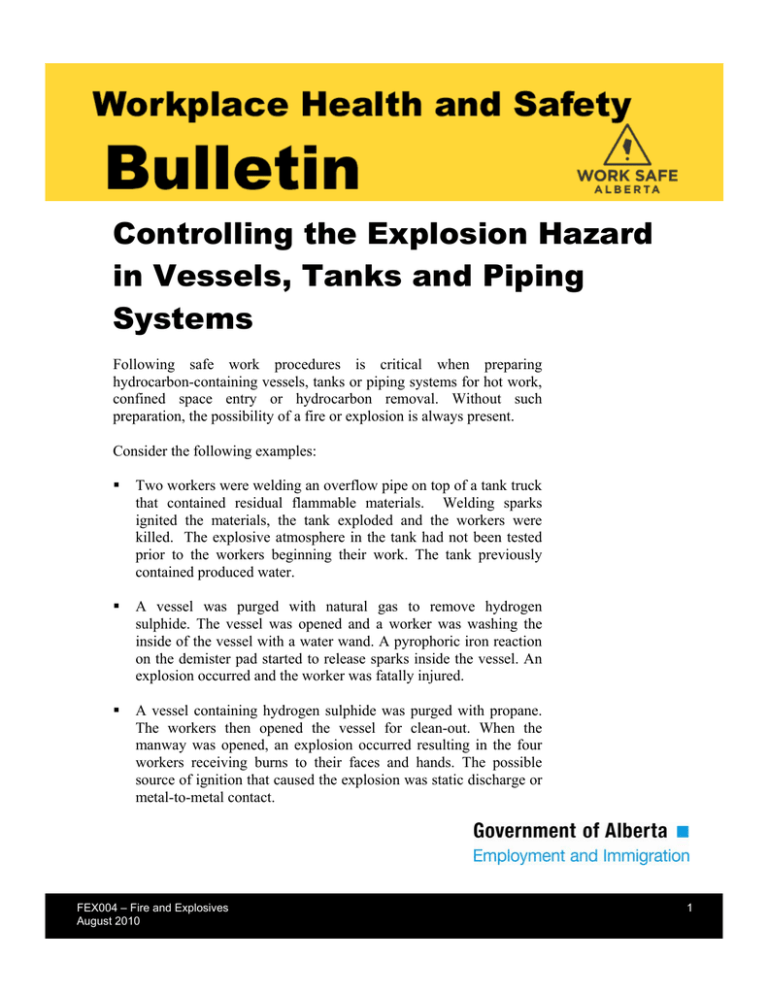
Controlling the Explosion Hazard in Vessels, Tanks and Piping Systems Following safe work procedures is critical when preparing hydrocarbon-containing vessels, tanks or piping systems for hot work, confined space entry or hydrocarbon removal. Without such preparation, the possibility of a fire or explosion is always present. Consider the following examples: Two workers were welding an overflow pipe on top of a tank truck that contained residual flammable materials. Welding sparks ignited the materials, the tank exploded and the workers were killed. The explosive atmosphere in the tank had not been tested prior to the workers beginning their work. The tank previously contained produced water. A vessel was purged with natural gas to remove hydrogen sulphide. The vessel was opened and a worker was washing the inside of the vessel with a water wand. A pyrophoric iron reaction on the demister pad started to release sparks inside the vessel. An explosion occurred and the worker was fatally injured. A vessel containing hydrogen sulphide was purged with propane. The workers then opened the vessel for clean-out. When the manway was opened, an explosion occurred resulting in the four workers receiving burns to their faces and hands. The possible source of ignition that caused the explosion was static discharge or metal-to-metal contact. FEX004 – Fire and Explosives August 2010 1 Atmospheric testing Before performing work involving a vessel, tank or piping system that contained or may contain hydrocarbons or other hazardous materials, the interior may need to be tested to determine if a flammable environment is present. Where testing is required, it must be done before work begins and may be required at regular intervals or continuously while conducting work. The most common unit of measuring the explosiveness is the percentage of the flammable mixture’s lower explosive limit (LEL). The LEL is the minimum concentrations of a substance that, when mixed with air, may ignite. If there is too little fuel, the air/fuel mixture is considered too “lean” and will not burn. The upper explosive limit (UEL) is the maximum amount of fuel that when mixed with air, can burn. If there is too much fuel, the air/fuel mixture is considered too “rich” and will not burn (see Figure 1). The wider the explosive range for a particular substance, the more likely it is to burn or explode when mixed with air. Figure 1 Graphic explanation of LEL and UEL Too lean Explosive range 0 LEL 0% LEL 100% LEL Too rich UEL 100% Saturation Using gasoline as an example, a 1.3 percent (by volume) mixture of gasoline vapour in air is equal to 100 percent of its LEL. This concentration is high enough to ignite and explode in the presence of an ignition source. When gasoline vapour reaches its LEL, a properly calibrated gas monitor (specifically calibrated for gasoline) will report the reading as 100 percent of the LEL. If the amount of gasoline vapour in air is 0.13 percent, then the instrument will report the reading as 10 percent of the LEL. Table 1 shows the LEL and UEL limits for selected hydrocarbon gases and liquids. FEX004 – Fire and Explosives August 2010 The most common unit of measuring explosiveness is the percentage of the flammable mixture’s lower explosive limit (LEL). 2 Table 1 LEL and UEL limits for selected hydrocarbon gases and liquids Flammable Substance Methane Ethane Propane Butane Hydrogen sulphide Toluene Gasoline Cutter oil Envirovert (drilling fluid) Crude oil Lower Explosive Limit (LEL) 5.3% 3% 2.3% 1.9% 4.0% 1.27% 1.3% 1.1% 0.7% <1% Upper Explosive Limit (UEL) 15% 12.5% 9.5% 8.5% 46% 7.0% 8.0% 6.0% 6.0% 10% For more information: http://employment.alberta.ca/documents/WHS/WHS-PUB_ch038.pdf Use of Combustible Gas Meters at the Work Site Flammable and combustible liquids Flammable and combustible liquids do not, by themselves, burn. It is the vapours given off by the liquid that form an ignitable mixture with air. The flash point is the lowest temperature at which the liquid gives off enough vapour to produce an ignitable mixture with air. The flashpoint of gasoline, for example, is about –40OC; the exact flash point varies with the grade of gasoline. This means that at temperatures as cold as –40OC, gasoline can still evaporate quickly enough that its vapours can create an ignitable atmosphere. Material Safety Data Sheets (MSDSs) provide information such as a product’s flashpoint and any precautionary measures that should be taken when handling the material. It is important to follow the advice provided in the MSDSs when using or working near a product. For more information http://employment.alberta.ca/documents/WHS/WHS-PUB_fex002.pdf Handling and Storage of Flammable Materials at the Work Site FEX004 – Fire and Explosives August 2010 Material Safety Data Sheets (MSDSs) provide information such as a product’s flash point and any precautionary measures that should be taken when handling the material. 3 Purging and inerting Where a vessel, tank or piping system previously contained hydrocarbons, it must be made safe for workers by purging or inerting before work begins. Purging displaces or flushes out hydrocarbons by introducing substances such as an inert gas, steam or water. Purging a hydrocarbon-filled system with air can create an explosive atmosphere. The work procedure must be evaluated to prevent this hazard. Using air as a purging gas significantly increases the risk of an explosion. Typically, air forced through a system containing a flammable or combustible liquid residue creates a mist cloud of airborne liquid droplets. Flammable liquid droplets evaporate quickly, and can produce an explosive atmosphere. If there is enough liquid residue, the explosive conditions may persist for a very long time – longer than workers may be willing to wait before beginning their work. An explosion that occurred in March 2000, highlights how unsafe the practice of using air as a purging gas can be (Figure 2). Three workers were killed and 15 others injured when a compressed gas tank exploded as workers were preparing a natural gas powered vehicle for crash tests. Air had been used to purge the tanks and lines that contained natural gas. An arc produced by the tank’s electrically operated valve ignited the mixture of natural gas and air. A noncombustible gas such as nitrogen or carbon dioxide should have been used to purge the system. As well, the tank valve should have been deenergized and locked out prior to work beginning. FEX004 – Fire and Explosives August 2010 Purging displaces or flushes out hydrocarbons by introducing substances such as an inert gas, steam or water. Using air as a purging gas significantly increases the risk of an explosion. 4 Figure 2 Results of an explosion due to inadequate purging Inerting displaces or dilutes the hydrocarbons in the vessel, tank or piping system with an inert (non-flammable and non-reactive) gas such as nitrogen or carbon dioxide, or a compatible inert liquid such as water. The atmosphere must remain non-explosive while workers perform their work. During the work, all ignition sources must be controlled so that they cannot trigger a fire or explosion. Note that inerting/purging themselves may create hazards to workers by displacing the oxygen in the environment. If a worker must enter a tank that has been inerted/purged, the proper procedures and protective equipment must be used. Also, LEL meters will not read properly when oxygen levels are less than 10 percent. Without enough oxygen, these meters can give an incorrect low reading even if flammable vapours and gases still remain. FEX004 – Fire and Explosives August 2010 5 Hot work If a vessel, tank or piping system has been used to contain a flammable substance or residue, the atmosphere inside must not exceed 20 percent of the substance’s LEL if hot work will be performed. Hot work is a work process that can generate enough heat to ignite a flammable mixture. Sources of ignition include: Open flames Electrical, friction or impact sparks Sparks resulting from the discharge of static electricity Hot surfaces such as engine manifolds and exhaust systems, brakes, hot bearings, welding or cutting torches, coils and resistors Heated gases Internal combustion engines Hot work must not be performed in an area, or on/in a vessel, tank or piping system where a flammable substance is present. If a vessel, tank or piping system contained a flammable substance or residue, the atmosphere inside must not exceed 20 percent of the substance’s LEL if hot work will be performed. Tests must be done to ensure that the work may be safely performed. Iron sulphide fires Iron sulphide is a pyrophoric material. This means that it can spontaneously ignite when exposed to air. It is created when iron oxide (rust) is converted into iron sulphide in an oxygen-free atmosphere where hydrogen sulphide gas is present or where the concentration of hydrogen sulphide (H2S) exceeds that of oxygen. When iron sulphide is subsequently exposed to air, it is oxidized back to iron oxide and either sulfur or sulfur dioxide gas is formed. This chemical reaction between iron sulphide and oxygen generates a considerable amount of heat. In fact, so much heat is released that individual particles of iron sulphide become incandescent and glow. This heat can ignite nearby flammable mixtures. Most refineries experience spontaneous ignition of iron sulphide either on the ground or inside equipment. Pyrophoric iron fires most commonly occur during shutdowns when equipment and piping are opened for inspection or maintenance. FEX004 – Fire and Explosives August 2010 6 Iron sulphide fires can be avoided by preventing the sulphide from contacting air. This can be achieved by maintaining a continuous layer of liquid or inert gas between the material and the air. Inerting vessels with nitrogen gas is one such method. Iron sulphide fires can be avoided by preventing the sulphide from contacting air. Inerting vessels with nitrogen gas is one such method. Personal protective equipment Workers may require respiratory and other personal protective equipment (PPE) when working with or near flammable or combustible materials. However, PPE is not an acceptable method of protecting workers against flammable or explosive atmospheres since it cannot adequately protect a person against the hazards of an explosion. Other controls such as inerting must be used. Regulatory requirements Part 10 of the Occupational Health and Safety (OHS) Code describes employer obligations involving fire and explosion hazards. Section 162 of the OHS Code prohibits persons from entering or working at a work area if more than 20 percent of the lower explosive limit of a flammable or explosive substance is present in the atmosphere unless the worker is competent, properly equipped and responding in an emergency, smoking or using an open flame in a work area where a flammable substance is stored, handled or processed, mixing, cleaning or using a flammable or combustible liquid at a temperature at or above its flash point in an open vessel if a potential source of ignition is in the immediate vicinity of the activity, and using a flammable or combustible liquid at a temperature above its flash point in a washing or cleaning operation unless the washing or cleaning equipment is specifically designed and manufactured for the use of the liquid. rags contaminated with flammable substances are stored in a labeled, covered container. FEX004 – Fire and Explosives August 2010 PPE cannot adequately protect a person against the hazards of an explosion, other controls such as inerting must be used. 7 Section 163 of the OHS Code requires the employer to develop procedures and precautionary measures to prevent flammable substances that are stored, handled, processed or present at a work site from igniting unintentionally. The employer must further ensure that the area does not contain enough of the substance to produce an explosive atmosphere, flammable substances are not stored within • 30 metres of an underground shaft, or • the immediate vicinity of the air intake of a ventilation supply system, an internal combustion engine, or the fire box of a fired heater or furnace, portable quantities of flammable liquids are only stored in containers approved to listed CSA, NFPA or ULC standards, and static electricity must be controlled when the contents of metallic or conductive containers are transferred from one container to another. Clothing contaminated with a flammable or combustible substance can create a serious hazard for the worker wearing it. Section 164 of the OHS Code requires the worker wearing the contaminated clothing to avoid activities that could lead to contact with a spark, remove the clothing at the earliest possible time, and ensure that the clothing is decontaminated before reuse. The worker must also wash their skin if a flammable or combustible material gets on it. Subsection 165 of the OHS Code requires that the employer, after having classified an area as a hazardous location based on its potential for creating an explosive atmosphere, develop procedures and precautionary measures to prevent ignition of the substance. The employer must further ensure that: equipment used in the hazardous location will not ignite the flammable substance, static electricity is controlled, and if the hazardous location is part of a larger work area, then the hazardous location is either • clearly identified to warn workers of the hazard, or • fenced off to prevent entry of workers and equipment into the location. where reasonably practicable, procedures and precautionary measures must be developed to prevent an inadvertent release of a flammable substance or oxygen gas if it can contact a flammable substance. If these procedures and cautionary measures cannot be developed, there must be measures in place to prevent an explosive atmosphere from igniting in a hazardous location. FEX004 – Fire and Explosives August 2010 8 The OHS Code defines hot work as work in which a flame is used or sparks or other sources of ignition may be produced, including: (a) cutting, welding, burning, air gouging, riveting, drilling, grinding, chipping, (b) using non-classified electrical equipment in a hazardous location, and (c) introducing a combusting engine to a work process. Tests related to hot work, as required by section 169 of the OHS Code, are conducted to determine whether the atmosphere contains a flammable substance in a quantity sufficient to create an explosive atmosphere. Subsection 169(2) requires the employer to ensure that hot work is not begun until: a permit is issued and the location is cleared of combustible materials, procedures have been implemented to ensure continuous safe performance of the hot work, and testing shows that the atmosphere does not contain • a flammable substance in a mixture with air, in an amount exceeding 20 percent of that substance’s lower explosive limit for gas or vapours, or • the minimum ignitable concentration for dust. When tests are required during hot work, the employer must ensure that tests are made at regular intervals appropriate to the hazards associated with the work being performed. Preparing a vessel, tank or piping system Consider the following when preparing to work with a vessel, tank or piping system that contains or may contain hydrocarbons: (1) Identify hazards – perform a thorough hazard assessment. (2) Follow procedures – procedures developed to control the identified hazards must be followed. (3) Competent workers – work must only be performed by qualified, trained and experienced worker . FEX004 – Fire and Explosives August 2010 9 (4) Material Safety Data Sheets (MSDSs) – follow the manufacturer’s handling recommendations and precautions. (5) Monitoring – use properly calibrated gas monitors that are appropriate for the atmosphere being monitored. (6) Prepare the site – the interior may need to be ventilated, purged, or inerted with a compatible gas or liquid. (7) Isolation – a vessel, tank or piping system may need to be isolated to prevent the flow of gases or vapours. (8) Venting – the contents of the vessel, tank or piping system may need to be safely vented to a flare or safe area. (9) Bonding and grounding – when flammable substances are transferred from one system or container to another, bonding and grounding of the components may be needed to eliminate sparks due to the discharge of static electricity. Hazard identification and assessment are essential parts of work planning. Workers must be trained to understand the importance fo identifying potentially hazardous conidtions. Hazard identification and assessment are essential parts of work planning. Workers must be trained to understand the importance of identifying potentially hazardous conditions. FEX004 – Fire and Explosives August 2010 10 Contact us: Province-Wide Contact Centre Web Site Edmonton 780-415-8690 Throughout Alberta 1-866-415-8690 www.worksafely.org (Toll Free) Deaf or hearing impaired Edmonton 780- 427-9999 Other locations 1-800-232-7215 (Toll Free) Getting copies of OHS Act, Regulation & Code: Queen’s Printer Workplace Health and Safety http://employment.alberta.ca/whs‐ohs www.qp.gov.ab.ca Edmonton 780-427-4952 Call any Government of Alberta office toll-free Dial 310-0000, then the area code and telephone number you want to reach © 2010-2011, Government of Alberta, Employment and Immigration This material may be used, reproduced, stored or transmitted for non-commercial purposes. The source of this material must be acknowledged when publishing or issuing it to others. This material is not to be used, reproduced, stored or transmitted for commercial purposes without written permission from the Government of Alberta, Employment and Immigration. This material is to be used for information purposes only no warranty express or implied is given as to the accuracy or the timeliness of the material presented. FEX004 – Fire and Explosives August 2010 11

